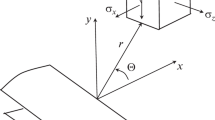Abstract
A criterion is derived to predict crack trajectories in two dimensional components, which is valid for finite strain fracture mechanics. First a relation between the curvature in mixed-mode crack propagation and the corresponding configurational forces is derived, based on the principle of maximum dissipation. With the help of this, a numerical scheme is presented which is based on a predictor-corrector method using the configurational forces acting on the crack together with their derivatives along real and test paths. With the help of this scheme it is possible to take bigger than usual propagation steps, represented by splines. Essential for this approach is the correct numerical determination of the configurational forces acting on the crack tip. The methods used by other authors are shortly reviewed and an approach valid for arbitrary non-homogenous and non-linear materials with mixed-mode cracks is presented. Numerical examples show, that the method is able to predict the crack paths in components with holes, stiffeners etc. with good accuracy.
Similar content being viewed by others
References
Bittencourt TN, Wawrzynek PA, Ingraffea AR, Sousa JL (1996) Quasi-automatic simulation of crack propagation for 2D LEFM problems. Eng Fract Mech 55: 321–334
Denzer R, Barth FJ, Steinmann P (2003) Studies in elastic fracture mechanics based on the material force method. Int J Num Meth Eng 58: 1817–1835
Goldstein RV, Salganik RL (1974) Brittle fracture of solids with arbitrary cracks. Int J Fract 10(4): 507–523
Le KC, Schütte H, Stumpf H (1999) Determination of the driving force acting on a kinked crack. Arch Appl Mech 69: 337–344
Mahnken R (2007) Material forces for crack analysis of functionally graded materials in adaptively refined FE-meshes. Int J Fract 147: 269–283
Maugin GA (1993) Material inhomogeneities in elasticity. Chapman and Hall, London
Miehe C, Grses E, Birkle M (2007) A computational framework of configurational-force-driven brittle fracture based on incremental energy minimization. Int J Fract 145: 245–259
Schütte H (2009) Curved crack propagation based on configurational forces. Comput Mater Sci 46(3): 642–646
Simha NK, Fischer FD, Shan GX, Chen CR, Kolednik O (2008) J-integral and crack driving force in elastic-plastic materials. J Mech Phys Solids 56: 2876–2895
Steinmann P, Ackermann D, Barth FJ (2001) Application of material forces to hyperelastic fracture mechanics. II. Computational setting. Int J Solids Struct 38: 5509–5526
Sumi Y, Yang C, Hayashi S (1996) Morphological aspects of fatigue crack propagation, part I. Computational procedure. Int J Fract 82: 205–220
Verron E, Andriyana A (2008) Definition of a new predictor for multiaxial fatigue crack nucleation in rubber. J Mech Phys Solids 56(2): 417–443
Williams M (1957) On the stress distribution at the base of a stationary crack. J Appl Mech 24: 109–114
Author information
Authors and Affiliations
Corresponding author
Rights and permissions
About this article
Cite this article
Schütte, H. On curved crack paths in finite strain fracture mechanics. Int J Fract 166, 145–151 (2010). https://doi.org/10.1007/s10704-010-9517-2
Received:
Accepted:
Published:
Issue Date:
DOI: https://doi.org/10.1007/s10704-010-9517-2




